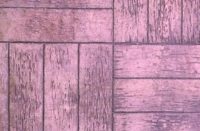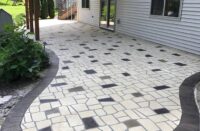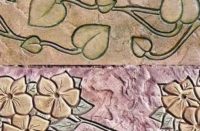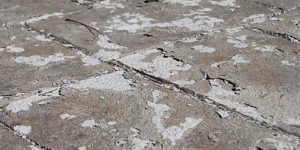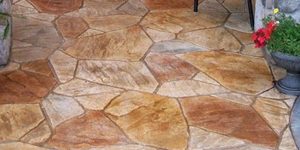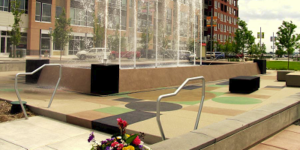Plenty of people have hobbies — the businessman who dabbles in winemaking, the social worker who paints with oils, the cop who gardens. But decorative concrete as a hobby?
Meet Kim Doehring, president of the Wichita, Kan., company Rockworx Concrete Design. He’s an aeronautical engineer by day, an award-winning decorative concrete artisan on the side.
Doehring’s work on the 10,000-square-foot Spirit AeroSystems courtyard in Wichita is, in a word, stunning. Doehring and his six-man crew transformed an area between the airliner-component company’s cafeteria and administration buildings from unattractive sidewalks and grass into a place where employees take breaks, gather for meetings and eat. The courtyard won 1st place in the Cast-in-Place Stamping — Over 1,500 Square Feet category in the 2011 Decorative Concrete Council Awards, given out by the American Society of Concrete Contractors Decorative Concrte Council
“The original courtyard was a plain concrete slab (sidewalks around a grassy area),” explains Doehring. “When Spirit split from Boeing and took over the buildings, they decided to do several facility upgrades. The intent of the courtyard renovation was to change the area from a transit zone between buildings to a usable employee area.”
Wichita-based Eby Construction Co. (Spirit’s construction contractor) was aware of Doehring’s moonlighting passion and asked him if he would be interested in the job.
Doehring recalls that Spirit had an initial design concept, but they didn’t have a full understanding of the scope of possibilities with decorative concrete.
“I worked with them to encourage a more unlimited design pallet and also helped them with color choices,” he says. “After learning about the processes involved and understanding the wider range of possibilities, they came back with a design in which they had incorporated many of my ideas with some of their own twists and concepts.”
The end result was a pattern integrating earth-tone colors stamped to mimic a slate pattern, all tied together with sweeping curved borders and circles.
“The idea was to provide an oasis within the aircraft facility, a place where employees can get away from aircraft for a while,” Doehring says. “Spirit added beautiful landscaping and a fountain, which adds to the effect. Speaking for myself, the area is regenerative, even when I’m just passing between buildings.”
 Achieving liftoff
Achieving liftoff
The first challenge for Doehring was to figure out how to get the concrete to the site. He was going to be doing the bulk of his concrete pours either after hours or on weekends – he was doing aircraft engineering during the day, after all – but he didn’t want to absorb the added expense associated with off-hours concrete pumping. He took some measurements and realized that a concrete truck would fit (barely) between the two buildings. With that realization, he simply had to set forms in sections, pouring incrementally from the rear of the courtyard forward.
Next, he had to build a crew that was willing to work evenings and weekends. The answer? His college-aged son and some of his son’s friends. “I had two guys with concrete experience, but the high school and college kids were great to have on the crew,” he recalls. “They worked hard, were enthusiastic and seemed to really enjoy learning about concrete.”
Placing, stamping and coloring
With his crew in place, Doehring set about forming and pouring concrete. “We used Plastiform forms to achieve the curves and circles in the layout, pouring the curved borders for each section first,” explains Doehring.
The borders, colored with Increte Desert Tan Color Hardener and Dark Gray release agent, were stamped with Increte Notched Ashlar Slate pattern stamps.
Once the forms were stripped and the concrete cured, the borders served as forms for the field concrete, in which he maintained continuity by stamping with Olde English Slate Pattern stamps. The field concrete was colored with Increte Peach Tone Color Hardener and Sand Buff release agent, creating a contrast to the colors in the borders.
Doehring finished off the job with Increte Clear Seal and Increte Shur-Grip nonslip additive. The Clear Seal will provide for easier snow removal during Kansas’ harsh winters and act as a physical barrier to protect the concrete from frequent salting, while Shur-Grip provides a safer slip-resistant surface year round.
About the awards
Bernie McGuire, marketing manager for Increte Systems Inc., submitted the Spirit AeroSystems job for the award it ultimately won.
“We like to follow up on each job that we supply materials for,” says McGuire. “When we see one that really stands out, we don’t hesitate to nominate it for an award. It’s a win all the way around … the contractors get well-deserved credit for outstanding work, and we feel good that we contributed to something special.”
McGuire says it was an easy decision to nominate Doehring’s work. “The look of the Spirit AeroSystems job was unique and really well done. The way the borders and patterns accented the entirety of the job was very interesting. It was definitely deserving of recognition.”
A true calling?
Doehring began working with decorative concrete shortly after the 9/11 tragedy. The aircraft industry had slowed to the point that he was laid off from his Boeing contract engineering job, and he turned to concrete to make ends meet. When the aircraft work recovered, he returned to engineering, but in the interim he had discovered that he truly enjoyed the craft of decorative concrete.
“As an engineer, I was fascinated with how anyone could make rocks out of concrete,” he says. “When I was temporarily laid off due to the aviation downturn, I spent that time learning how to fabricate, texture and color concrete. After completing a couple of concrete rock projects (for spas) I realized that there wasn’t enough demand for a newbie concrete rock builder, so I added stamping and coloring to my repertoire.
“After that, it was simply a matter of embracing the challenge of making every stamping project look as realistic as possible. It has never been about mass production. It’s more about the artistry and creativity of using concrete to simulate nature.”
So does Doehring plan on continuing with both concrete and aeronautical engineering?
“I just play it by ear,” he says. “I think I’ll always continue creating with concrete. I plan to start working on incorporating decorative concrete integrally into new homes, both inside and out. I have faith that concrete holds the most creative possibilities in our future homes.”
Project at a Glance
Client: Spirit AeroSystems Inc.
Contractor: Rockworx Concrete Designs, Wichita, Kansas | www.rockworx.com
Designers: Spirit AeroSystems, in collaboration with Rockworx Concrete Designs. | www.spiritaero.com
Scope of project Transform a boring 10,000-square-foot concrete area between two buildings into an attractive courtyard for employee use.
Most challening aspect: Complete the project on a deadline without disrupting the day-to-day operations of Spirit AeroSystems.
Products Used: The Plastiform Co. plastic concrete forms. Increte Systems products: Olde English Slate Pattern and Notched Ashlar Slate pattern stamps, Desert Tan and Peach Tone Color Hardeners, Dark Gray and Sand Buff release agents, Clear Seal acrylic resin sealer, Shur-Grip nonslip additive.
